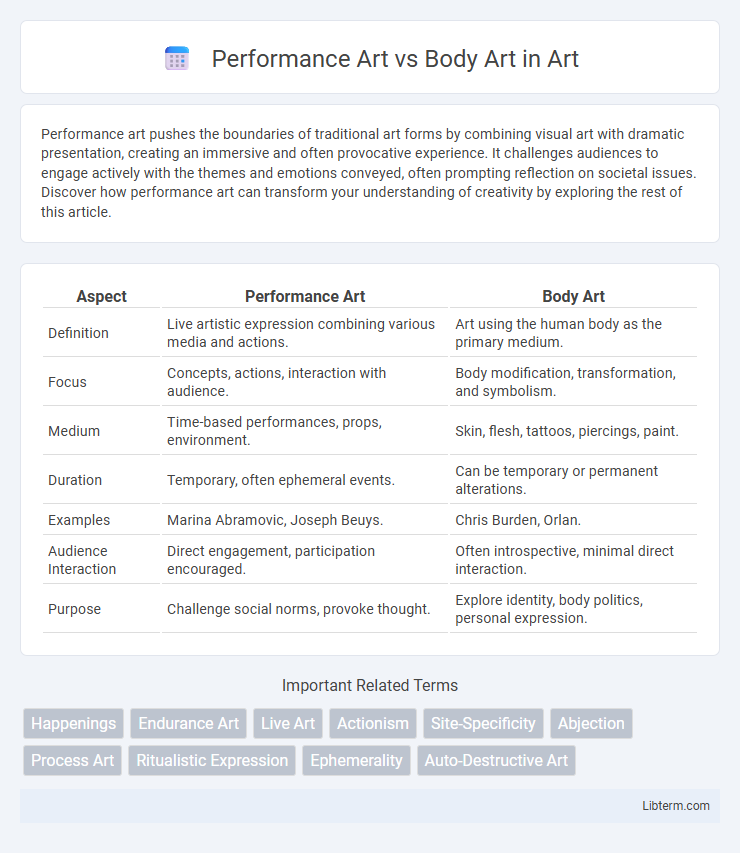Performance art pushes the boundaries of traditional art forms by combining visual art with dramatic presentation, creating an immersive and often provocative experience. It challenges audiences to engage actively with the themes and emotions conveyed, often prompting reflection on societal issues. Discover how performance art can transform your understanding of creativity by exploring the rest of this article.
Table of Comparison
| Aspect | Performance Art | Body Art |
|---|---|---|
| Definition | Live artistic expression combining various media and actions. | Art using the human body as the primary medium. |
| Focus | Concepts, actions, interaction with audience. | Body modification, transformation, and symbolism. |
| Medium | Time-based performances, props, environment. | Skin, flesh, tattoos, piercings, paint. |
| Duration | Temporary, often ephemeral events. | Can be temporary or permanent alterations. |
| Examples | Marina Abramovic, Joseph Beuys. | Chris Burden, Orlan. |
| Audience Interaction | Direct engagement, participation encouraged. | Often introspective, minimal direct interaction. |
| Purpose | Challenge social norms, provoke thought. | Explore identity, body politics, personal expression. |
Introduction to Performance Art and Body Art
Performance Art emerged in the 20th century as a dynamic form combining visual art with live actions, emphasizing the artist's presence and audience interaction. Body Art specifically uses the human body as both canvas and medium, exploring identity, transformation, and societal norms through physical expression. Both genres challenge traditional art boundaries by prioritizing temporal experience and embodied creativity over static objects.
Defining Performance Art: Key Concepts
Performance art emphasizes live, time-based presentations where the artist's actions and interactions with the audience become the artwork itself, often challenging traditional boundaries of visual art. It incorporates elements of theater, dance, and visual art, focusing on the conceptual and ephemeral experience rather than permanent objects. Key concepts include presence, temporality, audience engagement, and the artist's body as a medium within a broader performance context.
Understanding Body Art: An Overview
Body Art is a dynamic form of artistic expression that uses the human body as the primary medium, often involving tattoos, piercings, scarification, and body painting to convey cultural, political, or personal narratives. Unlike Performance Art, which emphasizes live actions and audience interaction, Body Art centers on the modification and presentation of the body itself as a visual statement. This art form challenges conventional aesthetics and explores identity, transformation, and societal norms through embodied creativity.
Historical Evolution of Performance Art
Performance art originated in the early 20th century with avant-garde movements like Dada and Futurism, emphasizing experimental, live artistic expression that challenged traditional art forms. Throughout the 1960s and 1970s, artists such as Marina Abramovic and Yoko Ono expanded performance art by incorporating the artist's body as a central medium, fostering direct interaction with audiences. This evolution set the stage for body art to emerge as a distinct genre focused specifically on the human body as both subject and canvas, blending performance with physical transformation.
Origins and Development of Body Art
Body Art originated in the 1960s as a subgenre of Performance Art, emphasizing the human body as the primary medium for artistic expression. Early pioneers such as Vito Acconci and Marina Abramovic used their own bodies to challenge traditional art forms and confront social, political, and personal issues directly. The development of Body Art expanded to include actions like piercing, tattooing, and body modifications, highlighting the integration of flesh and identity in contemporary art practices.
Major Artists and Iconic Works in Performance Art
Major artists in Performance Art include Marina Abramovic, whose groundbreaking work "The Artist Is Present" redefined audience interaction and endurance art, and Joseph Beuys, known for integrating social philosophy into pieces like "I Like America and America Likes Me." Chris Burden's "Shoot" challenged physical limits and the notion of risk in art, while Yoko Ono's "Cut Piece" questioned vulnerability and participation. These iconic works emphasize the ephemeral and experiential nature of Performance Art, distinguishing it from Body Art's primary focus on the artist's body as medium.
Influential Figures in Body Art
Influential figures in Body Art, such as Marina Abramovic and Chris Burden, redefined the boundaries between the artist's body and the artwork by using their physical presence as the primary medium. Abramovic's endurance-based performances challenge concepts of pain, vulnerability, and audience interaction, while Burden's dramatic acts of self-inflicted harm expose societal tensions surrounding the human form. Their groundbreaking approaches have been pivotal in shaping contemporary Body Art, distinguishing it from the broader category of Performance Art.
Techniques and Mediums: Performance vs Body Art
Performance Art often utilizes live actions, theatrical elements, and audience interaction as primary techniques, emphasizing temporality and unpredictability. Body Art centers on the human body as both the medium and canvas, employing tattooing, piercing, body painting, and scarification to create permanent or semi-permanent expressions. These mediums distinguish Performance Art's ephemeral, event-based nature from Body Art's focus on physical transformation and enduring bodily modifications.
Audience Interaction and Participation
Performance Art emphasizes dynamic audience interaction, often involving spectators as active participants to blur the boundary between art and viewer. Body Art centers on the artist's own body as the medium, where audience participation is more observational, focusing on the physical presence and transformation of the artist. Both forms challenge traditional art spectatorship but differ in the degree and nature of audience engagement.
Impact and Legacy in Contemporary Art
Performance art revolutionized contemporary art by emphasizing ephemeral, time-based experiences that challenge traditional gallery norms, creating a dynamic interaction between artist and audience. Body art, a subset of performance art, foregrounds the human body as both medium and message, exploring identity, vulnerability, and sociopolitical issues with visceral immediacy. Both forms have significantly influenced contemporary art by expanding definitions of artistic expression and inspiring participatory, experiential, and activist practices across global art scenes.
Performance Art Infographic

 libterm.com
libterm.com